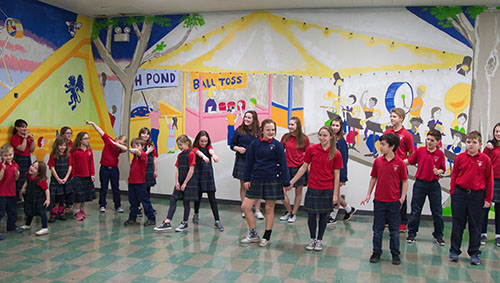PROGRAM SPARKS CREATIVITY, ENTHUSIASM FOR LEARNING
Walking the halls at St. Mark’s Catholic School in St. Paul, it’s not uncommon to hear references to brain development, neuroscience or even “purple cows.”
Now in its second year, the preschool- through eighth-grade school’s Catholic IDEALS program, which stands for innovation, differentiation, enrichment, activity, leadership and spirituality, is helping students understand the inner-workings of their brains to keep them engaged in their work and excited about learning.
“There’s something special about the atmosphere here,” Office Manager Brigid Kostka said. “We’re all looking for the “purple cows” in life — those things that intrigue us — and the best way for our brains to record what we’re trying to learn.”
This educational model also incorporates research from Harvard University’s Howard Gardner, who theorized that children learn best using nine different intelligences ranging from logical and mathematical to naturalistic and intrapersonal.
“We’re trying to use as much as we can from the world of neuroscience to help kids become wonderful beings and have strong academic futures,” Principal Zach Zeckser said.
Staff underwent extensive training during the summer of 2015, challenging them to weave different learning styles into their teaching. They also completed Top 20 training, which focuses on intra- and inter-personal skills to help students develop life skills related to thinking, learning and communicating.
Sarah Schwab, who teaches middle school science, sees a notable difference in her classroom. There’s more movement, music and technology in her lesson plans, and she works to immediately pique students’ curiosity each day with a demonstration set-up or a picture on the SMART Board.
“It’s helped the learning process by having kids understand how they learn and the science behind it,” she explained.
Last summer, University of St. Thomas Assistant Professor Mike Klein painted a 3,000 square-foot mural inspired by the program for the school’s cafeteria. Designed as a giant coloring book for students to fill in, the mural incorporates elements of the school alongside different learning styles, communication skills and those “purple cows.”
Bridget Hrabe, whose two children helped paint the mural, sees a difference in the language her children use and their enthusiasm for learning. Her daughter, Stella, 10, said the wide variety of teaching strategies makes learning more interesting. Her favorite learning style?
“Songs, because they are catchy and stick in my head,” she said. “I can remember things easier.”
Initial data points to a positive influence on both academics and engagement, and Zeckser looks forward to seeing the long-term impact at St. Mark’s and sharing that experience with other schools.
“We have learned so much about how [students’] brains work and how they can thrive,” he said.
